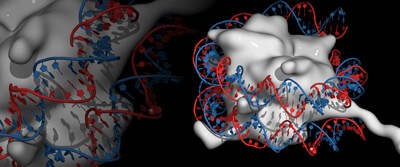Scientists Shed Light on DNA Repair

By Christina Phillis
Almost as easily as a glass gets knocked over and breaks, the DNA in cells within our bodies can be damaged when exposed to the right environmental factors. In response, molecular repair mechanisms find and fix mutations or other forms of damage. Now researchers from the University of North Carolina School of Medicine have demonstrated these functions in bacterial cells of two important excision repair proteins: Mfd and UvrD.
Nucleotide excision repair occurs in both human and bacterial cells when damaged sections of DNA, typically those exposed to ultraviolet light, are cut out in order to fix the strand. To better understand the molecular mechanisms behind excision repair, the team studied Escherichia coli bacteria. They used a recently developed technique called eXcision Repair-sequencing (XR-seq), which allows researchers to track which pieces of DNA are snipped during the repair process. First used in 2015 to create a UV repair map of the human genome, this method was employed in 2016 to generate the damage and repair maps of cisplatin for the entire genome. (Cisplatin is an anticancer drug that kills cancer cells by damaging their DNA.)
The Fixers
To observe the method behind bacterial DNA repair, the researchers brought about mutations by exposing E.coli bacteria to ultraviolet rays. They then used XR-seq to confirm which sections of the genome were being repaired.
During this process, they discovered that repairs were only happening in cells that contained the protein Mfd. In addition, they found that Mfd is what prompts other proteins to cut out damaged DNA for replacement, and reactivates molecular machinery that stops working due to damage. Another protein, UvrD, makes it possible for these proteins to clean up by unwinding the damaged DNA that has been cut out of the strand.
"The biochemical mechanisms of these proteins have been known for years from experiments involving purified protein and DNA, and that's very important, but in this new work we've clarified these proteins' roles in living cells," said co-senior author Christopher P. Selby, PhD, research assistant professor of biochemistry and biophysics at UNC.
These findings will not only help scientists learn more about DNA repair in humans, but also could lead to the development of better antibacterial drugs.
Discussion Questions
- Why might these findings be helpful when developing antibacterial drugs?
- What other advancements in medicine might come from better knowledge of DNA repair in humans?
- Mutation
- Proteins
- Genome
- Excision

